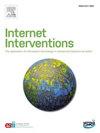Crowdsourcing integrated into a digital mental health platform for anxiety and depression: A pilot randomized controlled trial
IF 4.1
2区 医学
Q1 HEALTH CARE SCIENCES & SERVICES
Internet Interventions-The Application of Information Technology in Mental and Behavioural Health
Pub Date : 2024-09-11
DOI:10.1016/j.invent.2024.100774
引用次数: 0
Abstract
Background
Anxiety and depression are major public health concerns. Digital mental health interventions (DMHIs) are effective at reducing anxiety and depression, especially when they leverage human support. However, DMHIs that rely on human supporters tend to be less scalable. “Crowdsourced peer support,” in which a “crowd” of many peers provides users support via structured and focused interactions, may enable DMHIs to provide some of human support's unique benefits at scale.
Objective
To conduct a pilot trial of two versions of a digital mental health intervention for anxiety and depression: one with crowdsourced peer support and one without.
Methods
We conducted a two-armed pilot randomized controlled trial examining two versions of the novel “Overcoming Thoughts” platform: crowdsourced (intervention) vs. non-crowdsourced (control). The crowdsourced version allowed participants to view and interact with other users' content. We randomly assigned 107 participants to use the crowdsourced (n = 56) or non-crowdsourced (n = 51) platform for 8 weeks. Participants completed assessments at baseline, 4 weeks, 8 weeks, and 16 weeks. At each time point, these assessments included measures of anxiety and depression, including the Depression, Anxiety, and Stress Scale (DASS, primary outcome), the Patient Health Questionnaire (PHQ-9, secondary outcome), and the Generalized Anxiety Disorder Questionnaire (GAD-7, secondary outcome). We also collected usage information, including the number of exercises started, and safety data.
Results
Using mixed models controlling for demographic factors, we compared the conditions' effectiveness in reducing depression and anxiety over time. Although we found significant drops over time in the DASS at both Week 8 and Week 16 (ps < 0.01), we did not find significant treatment x time interactions (Week 8, p = 0.35; Week 16, p = 0.68). The PHQ-9 and GAD-7 showed similar results. The median number of times participants used the platform was 3 (mean = 6.99, SD = 9.78). Greater platform use was not associated with a different change in DASS total score, PHQ-9 score, or GAD-7 score over eight weeks (ps > 0.10).
Conclusions
Neither version of the “Overcoming Thoughts” platform (crowdsourced or non-crowdsourced) reduced anxiety or depression significantly more than the other. Future work should investigate how digital platforms can better leverage crowdsourced support, and if crowdsourced support may be especially useful in certain kinds of systems, populations, or target areas. Optimizing intervention engagement and obtaining the large sample sizes needed for appropriate statistical power will be key challenges for similar studies.
NCT: 04226742
将众包纳入数字心理健康平台,治疗焦虑症和抑郁症:随机对照试验
背景焦虑和抑郁是主要的公共健康问题。数字心理健康干预措施(DMHIs)能有效减少焦虑和抑郁,尤其是在利用人类支持的情况下。然而,依赖于人类支持者的数字心理健康干预措施的可扩展性往往较差。"众包同伴支持 "是指由众多同伴组成的 "人群 "通过有组织、有重点的互动为用户提供支持,这可能使 DMHIs 能够大规模地提供人类支持的一些独特优势。方法我们开展了一项双臂随机对照试验,对新颖的 "克服想法 "平台的两个版本进行了研究:众包(干预)与非众包(对照)。众包版本允许参与者查看其他用户的内容并与之互动。我们随机分配 107 名参与者使用众包平台(56 人)或非众包平台(51 人),为期 8 周。参与者分别在基线、4 周、8 周和 16 周时完成评估。在每个时间点,这些评估包括焦虑和抑郁测量,包括抑郁、焦虑和压力量表(DASS,主要结果)、患者健康问卷(PHQ-9,次要结果)和广泛性焦虑症问卷(GAD-7,次要结果)。我们还收集了使用信息,包括开始练习的次数和安全性数据。结果通过控制人口统计学因素的混合模型,我们比较了这些条件在减少抑郁和焦虑方面的有效性。虽然我们发现第 8 周和第 16 周的 DASS 随时间推移有明显下降(ps < 0.01),但我们没有发现治疗与时间的显著交互作用(第 8 周,p = 0.35;第 16 周,p = 0.68)。PHQ-9和GAD-7显示出相似的结果。参与者使用平台次数的中位数为 3 次(平均值 = 6.99,标准差 = 9.78)。结论 "克服想法 "平台的两个版本(众包或非众包)在减少焦虑或抑郁方面的效果都明显优于其他版本。未来的工作应研究数字平台如何更好地利用众包支持,以及众包支持在某些类型的系统、人群或目标领域是否特别有用。优化干预参与度和获得适当统计能力所需的大样本量将是类似研究面临的主要挑战。
本文章由计算机程序翻译,如有差异,请以英文原文为准。
求助全文
约1分钟内获得全文
求助全文
来源期刊

Internet Interventions-The Application of Information Technology in Mental and Behavioural Health
Medicine-Health Informatics
CiteScore
6.50
自引率
9.30%
发文量
94
审稿时长
6 weeks
期刊介绍:
Official Journal of the European Society for Research on Internet Interventions (ESRII) and the International Society for Research on Internet Interventions (ISRII).
The aim of Internet Interventions is to publish scientific, peer-reviewed, high-impact research on Internet interventions and related areas.
Internet Interventions welcomes papers on the following subjects:
• Intervention studies targeting the promotion of mental health and featuring the Internet and/or technologies using the Internet as an underlying technology, e.g. computers, smartphone devices, tablets, sensors
• Implementation and dissemination of Internet interventions
• Integration of Internet interventions into existing systems of care
• Descriptions of development and deployment infrastructures
• Internet intervention methodology and theory papers
• Internet-based epidemiology
• Descriptions of new Internet-based technologies and experiments with clinical applications
• Economics of internet interventions (cost-effectiveness)
• Health care policy and Internet interventions
• The role of culture in Internet intervention
• Internet psychometrics
• Ethical issues pertaining to Internet interventions and measurements
• Human-computer interaction and usability research with clinical implications
• Systematic reviews and meta-analysis on Internet interventions
 求助内容:
求助内容: 应助结果提醒方式:
应助结果提醒方式:


